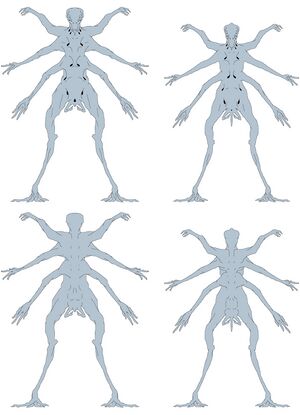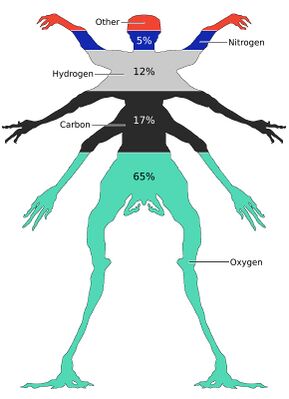Trrarrusian body (A1-0): Difference between revisions
No edit summary |
No edit summary Tag: 2017 source edit |
||
| Line 1: | Line 1: | ||
[[File:Anatomical trrarrusians.jpg|alt=Male (left) and female (right) adult trrarrusian bodies drawn in ventral (above) and dorsal (below) perspectives. Genetic modifications, physical modifications, prosthetics, clothing, and transitory gender have been deliberately not drawn to show anatomy.|thumb|Male (left) and female (right) adult trrarrusian bodies drawn in ventral (above) and dorsal (below) perspectives. Genetic modifications, physical modifications, prosthetics, clothing, and transitory gender have been deliberately not drawn to show anatomy.]] | [[File:Anatomical trrarrusians.jpg|alt=Male (left) and female (right) adult trrarrusian bodies drawn in ventral (above) and dorsal (below) perspectives. Genetic modifications, physical modifications, prosthetics, clothing, and transitory gender have been deliberately not drawn to show anatomy.|thumb|Male (left) and female (right) adult trrarrusian bodies drawn in ventral (above) and dorsal (below) perspectives. Genetic modifications, physical modifications, prosthetics, clothing, and transitory gender have been deliberately not drawn to show anatomy.]] | ||
The trrarrusian body is the structure of the [[Trrarrusian (A1-0)|trrarrusian being]]. It is composed of different cells that form tissues with different functions, which ensure the existence of the individual, its interaction with the medium and the continuation of the specie. | The trrarrusian body is the structure of the [[Trrarrusian (A1-0)|trrarrusian being]]. It is composed of different [[:en:Cell_(biology)|cells]] that form [[:en:Tissue_(biology)|tissues]] with different functions, which ensure the [[:en:Life|existence]] of the individual, its interaction with the medium and the continuation of the [[:en:Species|specie]]. | ||
It comprises a head (which holds most of the sensorial organs and the central nervous system), neck, torso (which holds most of the vital organs), arms and hands, and legs and feet. | It comprises a head (which holds most of the sensorial organs and the central nervous system), neck, torso (which holds most of the vital organs), arms and hands, and legs and feet. | ||
| Line 83: | Line 83: | ||
==== Nervous system ==== | ==== Nervous system ==== | ||
The nervous system is composed of the neuronal and glial cells, which are the basic structures of the nerves and neuronal mass, which constitute the brain and all other related structures. The nervous system serves the function of controlling many bodily functions, as automatic reactions, senses, memory, emotions, communication, rational thought, and others. The five main senses are touch, hearing, sight, taste, and balance. The eyes, tentacle, cochleas, skin, and spiracles recollect information from the environment that is then served to the nervous system. | |||
The nervous system is typically organized in two sections, the CNS (central nervous system) and the PNS (peripheral nervous system). The CNS is composed of the brain and the spinal cord, and it serves the function of sensory processing, memory, emotional reaction, linguistic communication, rational thought, voluntary motion, and possibly consciousness. Meanwhile, the PNS dedicates to the recollection of information, specially mechanoreception and thermoception, and involuntary movement through the nerves throughout the body. | |||
Once again, the nervous system can be divided into the SNS (somatic nervous system) and the ANS (autonomic nervous system). The SNS is responsible for voluntary actions, like speaking and voluntary movement, while the ANS is responsible of involuntary reactions like blood pressure, gender transition, or digestion. | |||
Revision as of 15:05, 21 August 2023

The trrarrusian body is the structure of the trrarrusian being. It is composed of different cells that form tissues with different functions, which ensure the existence of the individual, its interaction with the medium and the continuation of the specie.
It comprises a head (which holds most of the sensorial organs and the central nervous system), neck, torso (which holds most of the vital organs), arms and hands, and legs and feet.
The study of the Trrarrusian bodies includes multiple branches of anatomy, physiology, microbiology, chemistry, and oology. The trrarrusian body varies in known ways, both natural and artificial. All these studies ensures vital works as the cure of different trrarrusian diseases, a better understanding of the effects of implants and prosthetics, the creation of medicines used for enhancement of capabilities and the sustained health of trrarrusians in inhospitable locations, physiological rehabilitation of injured individuals, among others.
Composition
Trrarrusians are a carbon-based specie, composed of various elements, specifically carbon, oxygen, hydrogen, nitrogen, phosphorus and titanium. These elements are located in both cellular and extracellular mass.
The adult trrarrusian male body is composed of about 60% water in total, shared between extracellular fluids, blood plasma, interstitial fluids, and cellular fluids. The pH is carefully maintained rigorously, keeping a slightly alkaline pH level between 7.85 and 7.95 due to the high ammonia content required for metabolic processes. The most important electrolytes in extracellular fluids are potassium and chloride. Meanwhile, inside cells, the main electrolytes are sodium and phosphates.
Cells
Trrarrusian bodies are composed of cells. At maturity, there are roughly 59-74 trillion cells, an estimate reached with the volume of an adult trrarrusian body, the volume of each type of cell and the proportion of these cells in the body. The body also coexists with commensalist and symbiotic microorganism inside of it and on its skin, which feed on the excretion and dead cells of the individual, and in some cases serve essential roles in the body such as digestion, synthetizing of molecules and processing of atmospheric ammonia. A significant part of the total mass of the body isn't composed of cells, but extracellular tissues and material, as the protein matrix in which cells are housed, or extracellular fluids. Around 37%, or 48 kg of the 130 kg of the total mass is composed of symbiotic and commensalist organism, or non-cellular mass such as bones, connective tissues and fluids.
Genome
Cells are able to realize functions thanks to DNA. DNA in trrarrusian cells is located in a nucleus in the centre of the cells, in most cases. This DNA is used for the synthetizing of proteins within the cell, that regulate cell behaviour, metabolic processes and form structural components within and outside the cells. Some cells, as blood cells, lack DNA.
Tissues
The body is composed of multiple different kinds of cells that serve different purposes, the combination of various cells that serve the same purpose are categorized as tissues. The four main types of tissues are muscular, connective, nervous and lining cells.
Organs
The organs are usually located within the body, except for the skin. Examples include the hearts, lungs and gospaws. Many of these organs are housed in internal cavities in the body, as the abdomen, thorax, and pelvic cavity.
Systems
Nervous system
The nervous system is composed of the neuronal and glial cells, which are the basic structures of the nerves and neuronal mass, which constitute the brain and all other related structures. The nervous system serves the function of controlling many bodily functions, as automatic reactions, senses, memory, emotions, communication, rational thought, and others. The five main senses are touch, hearing, sight, taste, and balance. The eyes, tentacle, cochleas, skin, and spiracles recollect information from the environment that is then served to the nervous system.
The nervous system is typically organized in two sections, the CNS (central nervous system) and the PNS (peripheral nervous system). The CNS is composed of the brain and the spinal cord, and it serves the function of sensory processing, memory, emotional reaction, linguistic communication, rational thought, voluntary motion, and possibly consciousness. Meanwhile, the PNS dedicates to the recollection of information, specially mechanoreception and thermoception, and involuntary movement through the nerves throughout the body.
Once again, the nervous system can be divided into the SNS (somatic nervous system) and the ANS (autonomic nervous system). The SNS is responsible for voluntary actions, like speaking and voluntary movement, while the ANS is responsible of involuntary reactions like blood pressure, gender transition, or digestion.
